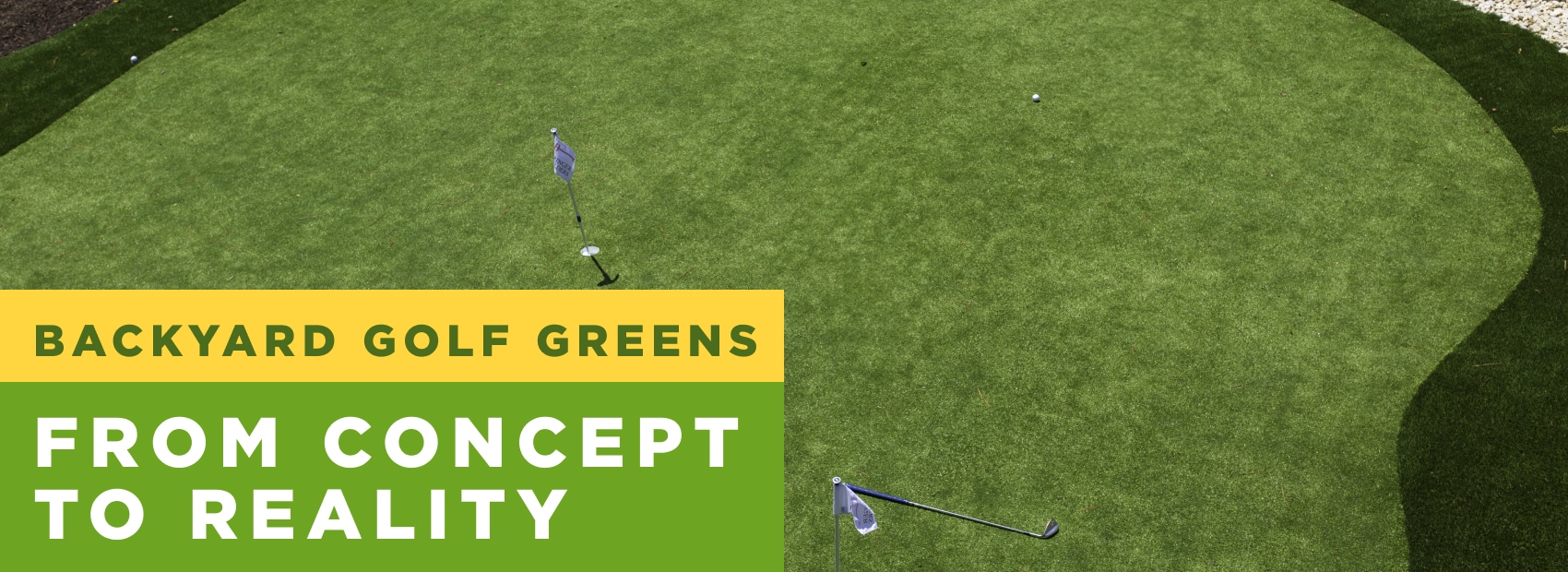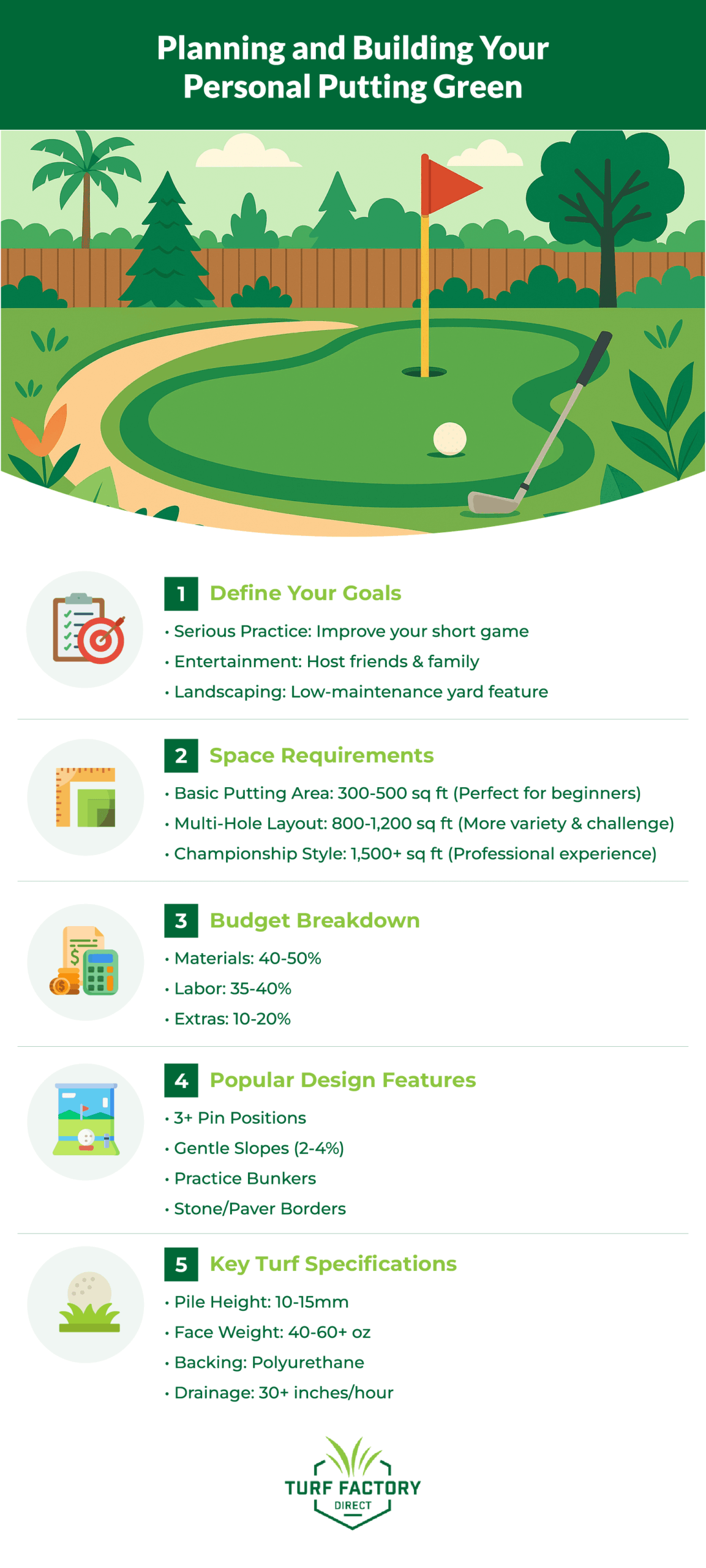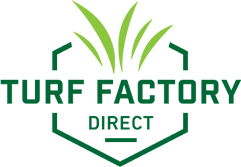
Imagine walking out after dinner for 20 minutes of focused putting practice—no drive to the course, no tee time required. Yes, a backyard putting green is absolutely achievable and transforms your yard into a personal golf retreat that sharpens your short game while creating a unique space family and friends will love.
Building a quality backyard putting green depends on smart planning, durable turf materials, reliable drainage, and an honest budget that ensures the finished result matches your expectations and skill level. Advances in synthetic turf have made home greens far more practical and easier to maintain compared to natural grass. The challenge lies in identifying your goals, evaluating your space, and making a realistic commitment before any digging begins.
Key Takeaways
- Success depends on upfront planning that balances available space, budget, and your ability to maintain the green.
- Both professional and DIY installation have strengths depending on skill and project scope.
- Long-term satisfaction requires the right materials and a clear understanding of maintenance needs from the start.
Planning Your Personal Putting Paradise
Designing a putting green that fits your property and lifestyle starts with aligning your goals, space, budget, and preferred features. The more deliberate you are in this phase, the more likely you’ll enjoy lasting satisfaction from the investment.
Understanding Your Goals and Space
Clarify your objectives before breaking ground. Do you want a place to seriously practice, host friends, or simply add a low-maintenance highlight to the yard?
Measure the available space carefully. A basic green usually needs at least 300–500 square feet, while larger multi-hole or championship layouts take up far more. Irregular shapes can make good use of awkward corners or work around patios, gardens, and fences.
Evaluate drainage and sunlight. Poor drainage causes pooling, while constant shade can shorten the life of certain turf types.
Space Requirements by Green Type:
- Basic putting area: 300–500 sq ft
- Multi-hole layout: 800–1,200 sq ft
- Championship-style green: 1,500+ sq ft
Also check for underground utilities, irrigation, or septic lines. Always contact your local utility service before scheduling excavation.
Budgeting and Cost Considerations
Costs depend on size, materials, and the complexity of installation. According to HomeAdvisor’s 2025 cost data, backyard putting greens average $4,300 with a typical range of $3,500 to $9,000. Professionally built greens usually run between $15–40 per square foot for synthetic turf systems, with pricing varying by size—smaller installations under 400 square feet average $33 per square foot, while larger installations over 2,000 square feet can drop to $20 per square foot due to economies of scale.
Understanding Value Beyond Initial Cost
USGA Green Section—the leading authority on golf course maintenance—has stated that a quality synthetic putting green can last 10-20 years with proper maintenance. That means a $5,000 investment breaks down to just $250-500 per year, or less than many golfers spend on a single weekend golf trip.
From a performance perspective, Golf Digest documented that a scratch golfer using structured practice routines showed measurable improvement in strokes-gained putting metrics over just nine 40-minute sessions—progressing from losing strokes to consistently gaining at least half a stroke per round. If consistent home practice helps you save just two strokes per round, that’s the difference between breaking 80 or shooting 82, between winning your club championship or finishing second.
Regarding property value, it’s important to set realistic expectations. While general landscaping improvements can increase home values, specialized features like putting greens appeal to a narrower buyer segment. Think of your putting green primarily as a lifestyle investment that enhances your golf game and backyard enjoyment rather than a guaranteed financial return at resale.
Typical Cost Breakdown:
- Materials (40–50%): Synthetic grass, base layers, infill
- Labor (35–40%): Excavation, installation, finishing
- Extras (10–20%): Borders, lighting, water features
Doing it yourself can cut 30–50% of costs but requires specialized tools, skill, and time. Factor in the possibility of mistakes and extra equipment rental.
High-end turf costs $3–8 per square foot, while budget turf starts around $2–4 per square foot. Cheaper options may not hold up as well under play or provide realistic roll. Options like TFD Nylon Putt Extreme offer premium durability, while TFD Birdie Putt Elite provides excellent performance at a mid-range price point.
Don’t overlook upkeep. Even quality turf requires brushing, infill replacement, and a professional cleaning every few years.
Design Elements and Features
Match your design choices with your golf goals. Simple shapes such as ovals or kidney layouts work well for beginners and those focusing purely on stroke mechanics.
Add elevation changes for variety—raising or lowering sections by even 6–12 inches can change the challenge without overcomplicating the build. For inspiration on creating dynamic contours, check out our guide on raised putting greens which explores elevation strategies in detail.
Popular Design Features:
- Three or more pin positions
- Gentle slopes and breaks (2–4% grade)
- Bunkers or artificial hazards
- Borders using stone or pavers
Water elements like streams or ponds look impressive but drive up costs. Simple alternatives like rock features or mulched areas can give a similar feel without the expense.
Plan how people will move around the green. Create pathways and clear access from your house that won’t trample landscaping. Picture yourself carrying your putter and a cold drink from the kitchen to your green on a summer evening—the path should be intuitive and inviting.
Material Selection
The turf you choose defines how the green plays. Look for putting-specific turf with short pile height and dense fiber density. The Synthetic Turf Council establishes minimum durability standards including tuft bind greater than 6.8 pounds and grab tear strength minimum 150 pounds. Modern synthetic putting greens can reach close to 13 feet on the Stimpmeter when properly constructed, approaching tour-quality green speeds.
Key Synthetic Grass Specifications:
- Pile height: 10–15mm for consistent ball speed
- Face weight: At least 40–60 oz for durability
- Backing: Polyurethane for stability
- Drainage: Capacity of 30+ inches per hour
- UV resistance: Essential for longevity in all climates
Turf Factory Direct offers several options engineered specifically for putting performance:
- TFD Nylon Putt Extreme: Premium nylon fibers for maximum durability and consistent ball roll
- TFD Poly Putt: High-performance polyethylene option balancing quality and value
- TFD Two Tone Putt: Distinctive appearance with professional-grade performance
- TFD Putting Elite: Tournament-quality surface for serious players
Choose infill suited to your needs—silica sand gives true roll, while rubber granules absorb traffic better. TFD Putting Green Silica Sand Infill is specifically designed to maintain consistent ball speed and provide the weight needed to keep turf fibers standing upright. The Sports Turf Managers Association emphasizes that keeping fibers standing upright minimizes wear and UV degradation, making proper infill essential for achieving your turf’s expected lifespan.
The base is just as critical. Use crushed stone, granite, and geotextile fabric to prevent settling and keep drainage strong.
Premium turf systems with multi-layer builds or shock pads cost more but deliver performance and durability for serious players. For more insights on material selection and installation, see our comprehensive article on golf greens at home.
From Installation to Enjoyment
Turning plans into a working green happens in three stages: construction, ongoing maintenance, and thoughtful upgrades that keep the experience fresh year after year.
The Construction Process
Professionals usually need two to three days for a standard build. The project begins with excavation to about 6–8 inches, followed by laying and compacting a crushed stone or granite base.
Why Drainage and Base Preparation Matter Most
According to STC’s technical guidelines, “an efficient and effective underground drainage system is an integral component of a synthetic turf system.” Poor drainage leads to standing water, moss growth, disrupted ball roll, and unsafe playing conditions that can void warranties and cause complete system failure. The STC specifies minimum water permeability of 10 inches per hour for the turf layer and 14 inches per hour for base materials.
USGA’s construction recommendations state that “subsurface drainage systems are a requirement of putting greens,” calling for 4-inch diameter perforated PVC drainage pipes with minimum 0.5% continuous slope, with lateral drains spaced no more than 15 feet apart. The USGA explicitly warns that “failure to follow these guidelines could result in greens failure.”
Base preparation requirements are exacting. The crushed stone must be properly graded with particle sizes tightly controlled to balance stability and permeability. Compaction standards require minimum 95% density, and surface tolerances must not exceed one-quarter inch in 10 feet. This isn’t the place to cut corners—a base that settles unevenly will create impossible putts and costly repairs.
Shaping the contours comes next, and this is where the green’s putting quality is defined. Be clear about whether you want beginner-friendly rolls or more challenging breaks. Think about the putts you struggle with most on the course—right-to-left breakers, downhill speed control—and design features that let you practice those specific challenges.
The turf is then seamed, stretched, and secured. Quality work should leave seams nearly invisible with smooth roll across the entire surface.
Finally, sand infill is applied—typically 2–3 pounds per square foot. This step stabilizes the fibers and ensures consistent putting conditions. Consider upgrading to TFD Putting Green Top Dressing for enhanced performance and turf longevity.
Maintenance Routines
The difference between a green that lasts 10 years versus 20 often comes down to simple maintenance routines. Here’s what matters most and why each task directly impacts your game.
Understanding The Why Behind Daily Care
Daily care is simple—five to ten minutes with a stiff broom keeps the surface uniform. But here’s why this matters: Keeping fibers standing upright minimizes wear and UV degradation. When fibers lay flat, they absorb more UV radiation and wear faster, shortening your green’s lifespan by years. More importantly for your game, matted fibers create inconsistent ball roll—the same six-foot putt might roll true in the morning but wobble off line by afternoon if you’ve neglected brushing. Regular brushing isn’t just maintenance; it’s preserving the consistent conditions that make your practice actually transfer to the course.
Weekly Care: Catching Problems Early
Weekly care means clearing debris and watching for standing water. Why does this matter? Organic matter like leaves and grass clippings don’t just look bad—they trap moisture against the turf backing, creating conditions for mold and bacteria growth. That small pile of leaves you ignore this week could become a dead spot requiring expensive turf replacement next month.
Standing water signals drainage issues that only worsen over time. Address issues early to prevent lasting damage—what starts as a small depression holding water after rain can become a major base failure requiring complete reconstruction if ignored.
Monthly Cleaning: Protecting Your Investment
Monthly cleaning involves hosing down the turf and applying antimicrobial treatment if needed. Clear away any organic matter to avoid mold or bacteria. If you invested $6,000 in your green, skipping monthly maintenance could cost you $300 per year in lost lifespan, far more than the hour of time monthly care requires.
Bunker areas should be raked regularly, with sand added as needed. Keep extra sand handy for quick repairs. Use TFD Putting Green Silica Sand Infill or TFD Putting Green Top Dressing to maintain optimal infill levels and playing conditions.
If you own portable turf sections, store them properly during extreme weather to avoid creasing.
Annual Professional Assessment
Plan for an annual professional inspection, typically costing $200–300, to catch early signs of wear before they turn into costly fixes. Think of this like an annual physical for your putting green. Catching a seam starting to separate or drainage beginning to slow costs hundreds to fix, while waiting until complete failure costs thousands.
Elevating Your Green Over Time
In the first year, focus on achieving a smooth, consistent roll. Add sand where needed and keep brushing to stabilize fibers. This is your foundation year—the period when you’ll discover your green’s personality and learn which putts challenge you most.
By the second year, consider adding LED lighting for evening play. Picture this: It’s a warm July evening, and you’ve just finished dinner with friends. Instead of heading inside, you flip on the soft border lighting around your green and challenge everyone to a putting contest under the stars. Border strip lights cost a few hundred dollars and extend your practice window while creating an ambiance that turns your backyard into the neighborhood gathering spot.
According to the National Association of Realtors’ outdoor features research, outdoor entertaining spaces provide some of the highest homeowner satisfaction ratings. Your putting green becomes more than practice equipment and becomes a destination that brings people together. For long-term expansion, add chipping zones, practice bunkers, or additional holes. Changing cup locations helps prevent wear and keeps the game interesting.
Advanced add-ons such as ball return systems or dedicated practice stations can be installed later. These upgrades often pay off by making the green more engaging. Consider installing TFD Professional Panels for modular expansion options.
Every few years, have professionals recondition the surface—re-sanding, repairing seams, and tuning the roll—so your investment continues to perform at its best. For home installations, budget $200-500 annually for infill replenishment and periodic deep cleaning to maintain peak performance.
The Long-Term Payoff
Structured putting practice interventions lead to measurable improvements in stroke play and shot shaping. Your backyard green isn’t just about convenience—it’s about deliberate practice that elite performers use to gain competitive edges. When you can walk outside for focused 20-minute sessions several times per week, you accumulate dozens of high-quality practice hours that recreational golfers never achieve. That consistency translates directly to confidence on the course when money’s on the line.
Ready to Install Your Backyard Putting Green?
Building your dream putting green starts with choosing the right turf. The difference between a good green and a great one often comes down to material quality, and there’s no substitute for feeling the turf under your hands and seeing how a ball actually rolls across different surfaces.
We invite you to experience Turf Factory Direct quality firsthand. Order your putting green samples today and compare different pile heights, fiber densities, and infill options in your own backyard. You’ll receive multiple samples delivered to your door, allowing you to:
- Test ball roll and speed on different turf types
- Feel the texture and density that separates premium from budget options
- Visualize how each option looks in your specific lighting and landscape
- Make a confident decision backed by hands-on experience, not just online photos
What looks perfect online might feel too soft or roll too fast for your preferences. Our samples let you discover exactly what works for your game before committing to your full installation.
Have questions about installation, maintenance, or choosing the right turf? Our team at Turf Factory Direct has helped thousands of golfers create their perfect practice space. Contact us for personalized guidance based on your specific goals, space, and budget.








